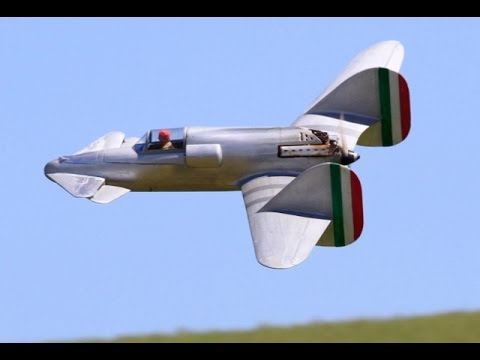ANOTHER “DIFFERENT” MODELED AIRCRAFT OF A PROTOTYPE WW2 ITALIAN CANNARD PUSHER PROP FIGHTER FROM TIM AT NLMFC,
Wikipedia says – The SAI-Ambrosini SS.4 was an Italian fighter prototype developed in the late 1930s, featuring a canard-style wing layout and a ‘pusher’ propeller. Development of the SS.4 was abandoned after the prototype crashed on its second flight.
The SS.4 was a single-seat fighter of all-metal construction with a canard configuration wing with twin fins mounted on the wing trailing edges, retractable tricycle undercarriage and short fuselage with rear-mounted engine driving a pusher propeller.
The pilot was accommodated in an enclosed cockpit in the centre of the fuselage forward of the two fuel tanks and aft of the armament in the nose. Visibility from the cockpit was excellent to the sides and front, but restricted to the rear by the large main wing, engine and large twin fins positioned at approximately the half-span position. Flying controls consisted of elevators on the trailing edges of the canard fore-plane controlling pitch, rudders on the large fins controlling yaw and ailerons on the main wings to control roll. Pitch trim was set by adjusting a trim tab on the starboard elevator.
The moderately swept, tapered, high aspect ratio wings had no sweep on the trailing edge and a cut back to give clearance for the propeller, with the large fins with rudders extending past the trailing edge at the ends of the cut-backs, to ensure enough moment to give adequate control and stability. The delta fore-plane was of low aspect ratio with the elevators sited below the trailing edge similar to the method used by contemporary Junkers aircraft like the Junkers Ju 87.
The engine was a powerful liquid-cooled Isotta-Fraschini Asso XI R.C.40 engine capable of 960 hp (720 kW) driving a three-bladed metal propeller. The engine was cooled by two radiators either side of the fuselage in ducts just behind the cockpit. Fuel for the engine was housed in two fuel tanks located mid-fuselage along with an oil tank.
Armament was to be two 20 mm (0.787 in) cannon and one 30 mm (1.181 in) cannon, clustered in the nose.
The prototype SS.4 was built by SAI Ambrosini, Passignano sul Trasimeno, and then sent to Eleuteri airport, Castiglione del Lago, also in the Trasimeno area. There, the aircraft was successfully flown for the first time on 7 March 1939. The next day the SS.4 prototype was scheduled to be transported to Aviano airbase by rail, but Ambrosini’s chief test pilot Ambrogio Colombo wanted a second test flight. After 45 minutes, an aileron malfunctioned just 2 km (1.2 mi) from Eleuteri. Colombo attempted to land but was unable to reach the runway and crashed near Campagna, hitting a tree. Colombo was killed when the engine pushed through the rear bulkhead and crushed him against the front of the cockpit. A memorial to him was erected near the site of the crash. The investigation into the crash concluded that the accident was due to imperfect construction which led to a faulty installation of the aileron which had failed. The study also pointed out the excessive vibrations transmitted by the engine to the wing.
FILMED AT NLMFC 7-6-2015,
PLEASE LIKE US ON FACEBOOK FOR VIDEO AND PICTURE UPDATES OF THE SHOWS AND CLUB FLY-INS –

